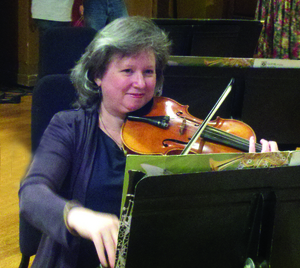

Dr. Theresa Lura plays violin with two orchestras and a string quartet. (Photo by Jim Benelisha)
In 2006 East Tennessee State University named Dr. Theresa Lura a "Notable Woman" for her achievements in the medical field. In her acceptance speech, entitled "Instant Pattern Recognition: How an Art Major Became a Pathologist," she traced her transformation from a student of the arts to an accomplished doctor of medicine.
"A direct relationship between art and medicine might not be obvious, but much of medicine is visual. Throughout anatomy, if I could draw what we were studying, I "knew' it," says Dr. Lura, assistant dean of women in medicine and clinical assistant professor in the department of pathology at the James H. Quillen College of Medicine.
Dr. Lura plays violin with the Johnson City Symphony Orchestra, the Milligan College Chamber Orchestra, and in a string quartet that plays for weddings. She also plays piano and guitar and sings. Previously she played violin with the Knoxville Symphony, the University of Tennessee Orchestra, the Eastern Kentucky University Orchestra, the Hamden (Conn.) Community Orchestra, and the Richmond (Va.) Community Orchestra.
She says, "Although I have played violin for 49 years now, I remain a true amateur, as my time to practice is limited; and I truly love to play. I play piano mostly by ear, haven't played guitar much since undergraduate school, and sing only in my church choir."
Dr. Lura is also a visual artist, painting primarily with oils, as well as doing pen-and-ink work with calligraphy, and ink sketches with and without watercolor washes. "Although I was privileged to study with Jim Gray in a Knoxville gallery in 1970, I never did master watercolors enough to consider myself a watercolor artist, certainly not in comparison with him!" she admits.
When Dr. Lura remarried during her first year of medical school, she wanted to have something new to do with her husband that she didn't share with others, so they took a class in stained glass. "We have since made a number of practical as well as artistic objects, including windows for a parlor at our church," she says.
"I was always interested in medicine, but in the early '70s (although I now know it wasn't true), it was rumored that women would not be considered seriously as candidates for medical school. While working as a secretary at Yale University, I was amazed at the quality and ease of access to health care available there in contrast to my experience growing up in Knoxville, Tenn. (Things were different there in the 1950s and '60s). I did not think about going to med school at the time, but it was my 'Aha!' moment; and I said to myself that the good folks of East Tennessee deserved the same quality and availability of health care as the folks in Connecticut received; and I was going to do something about it if I could when I got back home."
While working as a secretary, she flirted with the idea of becoming a professional artist. "I did calligraphy on commission, and sold various things at craft fairs. When I went back to school, my plan was to become a medical illustrator. My advisor at Milligan College, where I completed my B.S. degree in 1980, knew I was interested in medicine and suggested I consider medical school. 'You can always be a physician and draw, but you can't be an artist and practice medicine,' he said."
She notes, "It did get a little too much for a while, when I was playing in both the Johnson City and Kingsport symphonies, as well as ETSU's chamber orchestra (no longer in existence). I have not done much with the visual arts in a long time. I still do calligraphy for friends and family, though with calligraphic computer fonts, there is not as much interest these days in calligraphy by hand. I used to do artwork for the symphony about 10 years ago. I have lots of plans, but do mostly needlework and quilting these days."
As for playing music, she says, "It isn't a matter of finding time, it's more a necessity for me. It is part of what helps keep me at least semi-balanced. I never expected a conflict when I first started med school, until I got ready to leave for a symphony rehearsal while my classmates were studying for our first big anatomy exam. My classmates were astonished, thinking I was crazy to leave when everyone else would have three hours more to study than I would; but the rehearsal helped me realize there was more to life than an anatomy exam. I think I did better on that exam than I would have if I had studied straight through without that mental/emotional/spiritual break."
She concludes, "In addition to helping to create and maintain balance, helping create a better frame of mind and making a physician better equipped to manage whatever problems come his or her way, I think there are some ways in which music in particular can contribute to better care, such as making someone more in tune, so to speak, with heart sounds and rhythms, etc."
THERE'S MORE